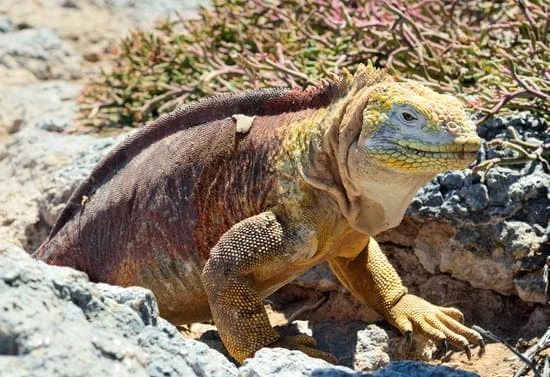
Galápagos Iguanas on the Move: A Story of Rescue and Restoration | Travel News
When Saving a Species Was Just A Hunch
The Early Rescue of Galapagos Land Iguanas
In the 1930s, efforts to conserve wildlife were few and far between. After witnessing the increase of human traffic on Baltra island, groups of land iguanas (Conolophus subcristatus) were moved, based simply on the notion of losing the population on Baltra, to the nearby North Seymour Island. There were no records of movement. It was not a plan, nor was it a scientific endeavor. In the end, the iguanas were removed from Baltra and were gone shortly thereafter.
Santiago Island: A Fitted Desert

Santiago Island was without its land iguanas for over 180 years. It was thought to be absent due to the introduction of goats, and the consequences to the vegetation, as pigs dug up the iguana nests. Removed from existence as an ecosystem engineer and herbivore, Santiago Island would never rebound in ecological patterns without its land iguanas.
North Seymour: A Growing Population
The iguanas that had been relocated to North Seymour adapted, thrived, and created a population exceeding 5,000 iguanas. What had originally been a rescue, evolved into an ecological incubator that grew thousands of iguanas that could be released throughout the Galapagos Islands, which was critical to ensuring a future for the species.
Restoration Linking Two Islands
Fast forward nearly 100 years, conservation evolved from a rescue to a restoration project. The iguanas that thrive on North Seymour are now being re-introduced back to Santiago Island to reactivate the lost ecological functions on that island. This project is being spearheaded by the Galápagos National Park Directorate and Galápagos Conservancy with assistance from Island Conservation.
The project involves capturing iguanas on North Seymour (quarantine) Island ensuring health checks, deworming, quarantining, queue guarding, and tagging. The operations work repeatedly, to ensure that the population dispersal remains stable on Santiago, once purportedly reintroduced, continual monitoring helps ensure a more or less self-sustaining population process between either glacier until discard occurs. The early reintroduction to the anticipated sites, like Punta Córdova, has already demonstrated new generations of hatching offspring which makes for a restoration project that is more recognizably an active corporeal reality!
The Ecological Importance of Land Iguanas
Land iguanas are ecological engineers and function as elemental indicators of island linkages. Seeds are dispersed, soil is loosened, spaces are created for making opportunities for other specie spatial basis and all else, ideally, happens wherever they roam. Land iguanas create opportunities for new cactus growth, which in tandem creates a continued ecosystem of sustenance.

When we think of these iguanas, they are an individual animal, but more a step by step recovery of a natural process that expects the use of time, not time selective machinery only being chosen for their unambiguous advantage and awesome force for the quick fix. Occasionally, we have observed iguanas climb low branches for warmth or food and have used that observation to depict the perfect example of adaptation to aridity, which makes iguanas not the one in the bush, but the bush- of a state.
Completing the Loop of Conservation
North Seymour Island is no longer a temporary refuge for land iguanas and will be a permanent source of land iguanas for re-stocking efforts. It is now time for Santiago Island, after nearly 200 years of iguana absence, to welcome their original inhabitants once again.
This month approximately one thousand iguanas make this journey as not just relocation, but a departure point for a new chapter in Galápagos restoration history, the intersection of science, history, and conservation in nature.

In the dry zones, plants are not just plants- they are sustenance for all life. For land iguanas every pad cactus is sustenance both, food and water- which sustains their reshaping of their landscape and their potential story of a species that was lost, now found and truly thriving.


